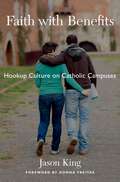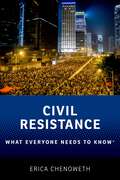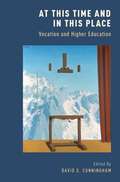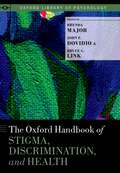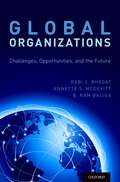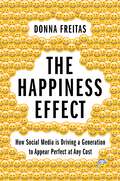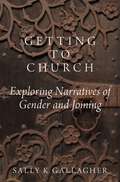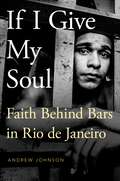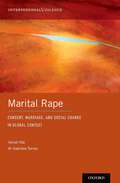- Table View
- List View
Faith with Benefits: Hookup Culture on Catholic Campuses
by Jason KingHookup culture has become widespread on college campuses, and Catholic colleges are no exception. Indeed, despite the fact that most students on Catholic campuses report being unhappy with casual sexual encounters, most studies have found no difference between Catholic colleges and their secular counterparts when it comes to hooking up. Drawing on a survey of over 1000 students from 26 institutions, as well as in-depth interviews, Jason King argues that religious culture on Catholic campuses can, in fact, have an impact on the school's hookup culture, but when it comes to how that relationship works: it's complicated. In Faith with Benefits, King shows the complex way these dynamics play out at Catholic colleges and universities. There is no straightforward relationship between orthodoxy and hookup culture--some of the schools with the weakest Catholic identities also have weaker hookup cultures. And not all students define the culture in the same way. Some see a hookup as just a casual encounter, where others see it as a gateway to a relationship. Faith with Benefits gives voice to students, revealing how their faith, the faith of their friends, and the institutional structures of their campus give rise to different hookup cultures. In doing so, King addresses the questions of students who don't know where to turn for practical guidance on how to navigate ever-shifting campus cultures, reconciling their faith with their relationships. Students, parents, faculty, administrators-indeed, anyone who cares about Catholic teenagers and young adults-will find much of value in this book.
Agents of God: Boundaries and Authority in Muslim and Christian Schools
by Jeffrey GuhinSociologist Jeffrey Guhin spent a year and a half embedded in four high schools in the New York City area -- two of them Sunni Muslim and two Evangelical Christian. At first pass, these communities do not seem to have much in common. But under closer inspection Guhin finds several common threads: each school community holds to a conservative approach to gender and sexuality, a hostility towards the theory of evolution, and a deep suspicion of secularism. All possess a double-sided image of America, on the one hand as a place where their children can excel and prosper, and on the other hand as a land of temptations that could lead their children astray. He shows how these school communities use boundaries of politics, gender, and sexuality to distinguish themselves from the secular world, both in school and online. Guhin develops his study of boundaries in the book's first half to show how the school communities teach their children who they are not; the book's second half shows how the communities use "external authorities" to teach their children who they are. These "external authorities" -- such as Science, Scripture, and Prayer -- are experienced by community members as real powers with the ability to issue commands and coerce action. By offloading agency to these external authorities, leaders in these schools are able to maintain a commitment to religious freedom while simultaneously reproducing their moral commitments in their students. Drawing on extensive classroom observation, community participation, and 143 formal interviews with students, teachers, and staff, this book makes an original contribution to sociology, religious studies, and education.
CIVIL RESISTANCE WENK C: What Everyone Needs to Know® (What Everyone Needs To Know®)
by Erica ChenowethA sweeping overview of civil resistance movements around the world that explains what they are, how they work, why they are often effective, and why they can fail. Civil resistance is a method of conflict through which unarmed civilians use a variety of coordinated methods (strikes, protests, demonstrations, boycotts, and many other tactics) to prosecute a conflict without directly harming or threatening to harm an opponent. Sometimes called nonviolent resistance, unarmed struggle, or nonviolent action, this form of political action is now a mainstay across the globe. It was been a central form of resistance in the 1989 revolutions and in the Arab Spring, and it is now being practiced widely in Trump's America. If we are going to understand the manifold protest movements emerging around the globe, we need a thorough understanding of civil resistance and its many dynamics and manifestations. In Civil Resistance: What Everyone Needs to Know® , Erica Chenoweth -- one of the world's leading scholars on the topic--explains what civil resistance is, how it works, why it sometimes fails, how violence and repression affect it, and the long-term impacts of such resistance. Featuring both historical cases of civil resistance and more contemporary examples such as the Arab Awakenings and various ongoing movements in the United States, this book provides a comprehensive yet pithy overview of this enormously important subject.
Civil Resistance: What Everyone Needs to Know® (What Everyone Needs To Know®)
by Erica ChenowethA sweeping overview of civil resistance movements around the world that explains what they are, how they work, why they are often effective, and why they can fail. Civil resistance is a method of conflict through which unarmed civilians use a variety of coordinated methods (strikes, protests, demonstrations, boycotts, and many other tactics) to prosecute a conflict without directly harming or threatening to harm an opponent. Sometimes called nonviolent resistance, unarmed struggle, or nonviolent action, this form of political action is now a mainstay across the globe. It was been a central form of resistance in the 1989 revolutions and in the Arab Spring, and it is now being practiced widely in Trump's America. If we are going to understand the manifold protest movements emerging around the globe, we need a thorough understanding of civil resistance and its many dynamics and manifestations. In Civil Resistance: What Everyone Needs to Know® , Erica Chenoweth -- one of the world's leading scholars on the topic--explains what civil resistance is, how it works, why it sometimes fails, how violence and repression affect it, and the long-term impacts of such resistance. Featuring both historical cases of civil resistance and more contemporary examples such as the Arab Awakenings and various ongoing movements in the United States, this book provides a comprehensive yet pithy overview of this enormously important subject.
At This Time and In This Place: Vocation and Higher Education
by David S. CunninghamSeeking to deepen current scholarly engagement with vocational exploration in both theory and practice, At This Time and In This Place champions the themes of calling and vocation as key elements of effective undergraduate education. Growing out of a year-long seminar sponsored by the Council of Independent Colleges and its Network for Vocation in Undergraduate Education (NetVUE), this book brings together a nationwide group of scholars from a variety of disciplines in order to produce new scholarly writing on this topic. It offers a historical and theoretical account of vocational reflection and discernment and also suggests how these endeavors can be carried out through specific educational practices. Attending both to the current state of higher education and to broader cultural trends, the contributors examine the contours of vocation from historical, theological, and philosophical perspectives. They consider the relationship between vocation and virtue, both of which encourage the cultivation of habits that lead to a life marked by flourishing and fulfillment-for oneself and for others. The authors also discuss how to engage students in actively reflecting on questions of meaning and purpose through classroom conversations, co-curricular activities, programs for community engagement, and attention to a campus's physical features. At This Time and In This Place offers a compelling argument for vocational reflection and discernment in undergraduate education and represents a significant contribution to the emerging scholarly literature in this field.
At This Time and In This Place: Vocation and Higher Education
Seeking to deepen current scholarly engagement with vocational exploration in both theory and practice, At This Time and In This Place champions the themes of calling and vocation as key elements of effective undergraduate education. Growing out of a year-long seminar sponsored by the Council of Independent Colleges and its Network for Vocation in Undergraduate Education (NetVUE), this book brings together a nationwide group of scholars from a variety of disciplines in order to produce new scholarly writing on this topic. It offers a historical and theoretical account of vocational reflection and discernment and also suggests how these endeavors can be carried out through specific educational practices. Attending both to the current state of higher education and to broader cultural trends, the contributors examine the contours of vocation from historical, theological, and philosophical perspectives. They consider the relationship between vocation and virtue, both of which encourage the cultivation of habits that lead to a life marked by flourishing and fulfillment-for oneself and for others. The authors also discuss how to engage students in actively reflecting on questions of meaning and purpose through classroom conversations, co-curricular activities, programs for community engagement, and attention to a campus's physical features. At This Time and In This Place offers a compelling argument for vocational reflection and discernment in undergraduate education and represents a significant contribution to the emerging scholarly literature in this field.
The Risk of a Lifetime: How, When, and Why Procreation May Be Permissible
by Rivka WeinbergHaving children is probably as old as the first successful organism. It is often done thoughtlessly. This book is an argument for giving procreating some serious thought, and a theory of how, when, and why procreation may be permissible. Rivka Weinberg begins with an analysis of the kind of act procreativity is and why we might be justifiably motivated to engage in it. She then proceeds to argue that, by virtue of our ownership and control of the hazardous material that is our gametes, we are parentally responsible for the risks we take with our gametes and for the persons that develop when we engage in activity that allows our gametes to unite with others and develop into persons. Further argument establishes that when done respectfully, and in cases where the child's chances of leading a life of human flourishing are high, procreation may be permissible. Along the way, Weinberg argues that the non-identity problem is a curiously common mistake. Arguments intending to show that procreation is impermissible because life is bad for people and imposed on them without their consent are shown to have serious flaws. Yet because they leave us with lingering concerns, Weinberg argues that although procreation is permissible under certain conditions, it is not only a welfare risk but also a moral risk. Still, it is a risk that is often permissible for us to take and impose, given our high level of legitimate interest in procreativity. In order to ascertain when the procreative risk is permissible to impose, contractualist principles are proposed to fairly attend to the interests prospective parents have in procreating and the interests future people have in a life of human flourishing. The principles are assessed on their own merits and in comparison with rival principles. They are then applied to a wide variety of procreative cases.
The Oxford Handbook of Stigma, Discrimination, and Health (Oxford Library of Psychology)
Stigma leads to poorer health. Edited by Brenda Major, John F. Dovidio, and Bruce G. Link, The Oxford Handbook of Stigma, Discrimination, and Health provides compelling evidence from various disciplines in support of this thesis and explains how and why health disparities exist and persist. Stigmatization involves distinguishing people by a socially conferred "mark," seeing them as deviant, and devaluing and socially excluding them. The core insight of this book is that the social processes of stigma reliably translate into the biology of disease and death. Contributors elucidate this insight by showing exactly how stigma negatively affects health and creates health disparities through multiple mechanisms operating at different levels of influence. Understanding the causes and consequences of health disparities requires a multi-level analysis that considers structural forces, psychological processes, and biological mechanisms. This volume's unique multidisciplinary approach brings together social and health psychologists, sociologists, public health scholars, and medical ethicists to comprehensively assess stigma's impact on health. It goes beyond the common practice of studying one stigmatized group at a time to examine the stigma-health link across multiple stigmatized groups. This broad, multidisciplinary framework not only illuminates the significant effects stigma has when aggregated across the health of many groups but also increases understanding of which stigma processes are general across groups and which are particular to specific groups. Here, a compendium of leading international experts point readers toward potential policy responses and possibilities for intervention as well as to the large gaps in understanding that remain. This book is the definitive source of scholarship on stigma and physical health for established and emerging scholars, practitioners, and students in psychology, sociology, public health, medicine, law, political science, geography, and the allied disciplines.
Artists of the Possible: Governing Networks and American Policy Change since 1945 (Studies in Postwar American Political Development)
by Matt GrossmannDo policymakers heed the voices of the American public or only the lobbyists in Washington? Why do they take action on health reform, but not gun control? Why does policymaking usually move slowly, and sometimes not at all? Artists of the Possible takes on these questions, analyzing sixty years of domestic policy history to provide a new understanding of what drives policymaking in all three branches of government. The results are surprising: public policy does not address the public's largest concerns. The amount of policy-and its liberal or conservative direction-emerges instead from coalition building and compromises among political elites. Elections, public opinion, and media coverage have little impact, no matter the issue area. Even changes in Washington's partisan balance and ideological divides fail to reliably produce shifts in policy direction. This data-rich, exhaustively researched work overturns our most basic assumptions about how policy is made, challenging the notion that our government is of, by, and for the people.
Democratic Theory and Mass Incarceration (Studies in Penal Theory and Philosophy)
The United States leads the world in incarceration, and the United Kingdom is persistently one of the European countries with the highest per capita rates of imprisonment. Yet despite its increasing visibility as a social issue, mass incarceration - and its inconsistency with core democratic ideals - rarely surfaces in contemporary Anglo-American political theory. Democratic Theory and Mass Incarceration seeks to overcome this puzzling disconnect by deepening the dialogue between democratic theory and punishment policy. This collection of original essays initiates a multi-disciplinary discussion among philosophers, political theorists, and criminologists regarding ways in which contemporary democratic theory might begin to think beyond mass incarceration. Rather than viewing punishment as a natural reaction to crime and imprisonment as a sensible outgrowth of this reaction, the volume argues that crime and punishment are institutions that reveal unmet demands for public oversight and democratic influence. Chapters explore theoretical paths towards de-carceration and alternatives to prison, suggest ways in which democratic theory can strengthen recent reform movements, and offer creative alternatives to mass incarceration. Democratic Theory and Mass Incarceration offers guideposts for critical thinking about incarceration, examining ways to rebuild crime control institutions and create a healthier, more just society.
Work and the Social Safety Net: Labor Activation in Europe and the United States (INTERNATIONAL POLICY EXCHANGE SERIES)
During the first two decades of the twenty-first century, the United States and much of the developed world were rocked by three successive economic shocks, each one more severe than the one before. Real relief from these economic shocks, of course, can only come from a restored economy--with balanced strength across many sectors and regions. Safety-net programs can also help alleviate this suffering. They provide urgent financial help and, when properly designed, can assist, motivate, or nudge recipients to seek and accept new employment. When necessary, they can help recipients to learn new skills and engage in other socially preferred behaviors. That is, they can "activate" the unemployed and underemployed. Work and the Social Safety Net: Labor Activation in Europe and the United States describes how in the 1990s and early 2000s many European countries adopted policy reforms aimed at activating those recipients apparently able to work. These policy reforms were put to the test during the Great Recession and its aftermath. This volume reviews the experiences from both Europe and the United States during this period, and includes two chapters apiece on unemployment insurance, social assistance, disability, public employment services, and political economy. Work and the Social Safety Net identifies policies for activating recipients of safety-net programs while still preserving a strong social safety net--as a guide during the economic recovery from the COVID-19 pandemic and future downturns.
Global Organizations: Challenges, Opportunities, and the Future
by Rabi S. Bhagat Annette S. McDevitt B. Ram BaligaThe 21st century is often characterized as the age of globalization, with the world's economies becoming more and more interconnected at an unprecedented rate. And while the phenomenon of globalization isn't necessarily new, it has taken on a drastically different form since the 1980s: competition amongst multinational and global organizations is more intense, and non-Western multinationals are now emerging as important players in the global economy. Today, professional managers need to reconcile the opportunities and challenges associated with the rapid growth of Asian, Eastern European, and Latin American countries. To do so, adopting what's called 'the global mindset' is becoming an essential skill for managers within these global organizations. The key advantages of developing a global mindset are many. In Global Organizations: Challenges, Opportunities, and the Future, authors Rabi S. Bhagat, Annette S. McDevitt, and B. Ram Baliga offers an insightful and comprehensive overview of the most important issues today for managers looking to develop and nurture their own global mindset for their company's future. Global Organizations expertly provides readers with research- and evidence-based knowledge on the significance of developing a sophisticated global mindset regardless of national identity or geographic locale.
Global Organizations: Challenges, Opportunities, and the Future
by Rabi S. Bhagat Annette S. McDevitt B. Ram BaligaThe 21st century is often characterized as the age of globalization, with the world's economies becoming more and more interconnected at an unprecedented rate. And while the phenomenon of globalization isn't necessarily new, it has taken on a drastically different form since the 1980s: competition amongst multinational and global organizations is more intense, and non-Western multinationals are now emerging as important players in the global economy. Today, professional managers need to reconcile the opportunities and challenges associated with the rapid growth of Asian, Eastern European, and Latin American countries. To do so, adopting what's called 'the global mindset' is becoming an essential skill for managers within these global organizations. The key advantages of developing a global mindset are many. In Global Organizations: Challenges, Opportunities, and the Future, authors Rabi S. Bhagat, Annette S. McDevitt, and B. Ram Baliga offers an insightful and comprehensive overview of the most important issues today for managers looking to develop and nurture their own global mindset for their company's future. Global Organizations expertly provides readers with research- and evidence-based knowledge on the significance of developing a sophisticated global mindset regardless of national identity or geographic locale.
The Happiness Effect: How Social Media is Driving a Generation to Appear Perfect at Any Cost
by Donna FreitasSexting. Cyberbullying. Narcissism. Social media has become the dominant force in young people's lives, and each day seems to bring another shocking tale of private pictures getting into the wrong hands, or a lament that young people feel compelled to share their each and every thought with the entire world. Have smartphones and social media created a generation of self-obsessed egomaniacs? Absolutely not, Donna Freitas argues in this provocative book. And, she says, these alarmist fears are drawing attention away from the real issues that young adults are facing. Drawing on a large-scale survey and interviews with students on thirteen college campuses, Freitas finds that what young people are overwhelmingly concerned with--what they really want to talk about--is happiness. They face enormous pressure to look perfect online--not just happy, but blissful, ecstatic, and fabulously successful. Unable to achieve this impossible standard, they are anxious about letting the less-than-perfect parts of themselves become public. Far from wanting to share everything, they are brutally selective when it comes to curating their personal profiles, and worry obsessively that they might unwittingly post something that could come back to haunt them later in life. Through candid conversations with young people from diverse backgrounds, Freitas reveals how even the most well-adjusted individuals can be stricken by self-doubt when they compare their experiences with the vast collective utopia that they see online. And sometimes, as on anonymous platforms like Yik Yak, what they see instead is a depressing cesspool of racism and misogyny. Yet young people are also extremely attached to their smartphones and apps, which sometimes bring them great pleasure. It is very much a love-hate relationship. While much of the public's attention has been focused on headline-grabbing stories, the everyday struggles and joys of young people have remained under the radar. Freitas brings their feelings to the fore, in the words of young people themselves. The Happiness Effect is an eye-opening window into their first-hand experiences of social media and its impact on them.
The Happiness Effect: How Social Media is Driving a Generation to Appear Perfect at Any Cost
by Donna FreitasSexting. Cyberbullying. Narcissism. Social media has become the dominant force in young people's lives, and each day seems to bring another shocking tale of private pictures getting into the wrong hands, or a lament that young people feel compelled to share their each and every thought with the entire world. Have smartphones and social media created a generation of self-obsessed egomaniacs? Absolutely not, Donna Freitas argues in this provocative book. And, she says, these alarmist fears are drawing attention away from the real issues that young adults are facing. Drawing on a large-scale survey and interviews with students on thirteen college campuses, Freitas finds that what young people are overwhelmingly concerned with--what they really want to talk about--is happiness. They face enormous pressure to look perfect online--not just happy, but blissful, ecstatic, and fabulously successful. Unable to achieve this impossible standard, they are anxious about letting the less-than-perfect parts of themselves become public. Far from wanting to share everything, they are brutally selective when it comes to curating their personal profiles, and worry obsessively that they might unwittingly post something that could come back to haunt them later in life. Through candid conversations with young people from diverse backgrounds, Freitas reveals how even the most well-adjusted individuals can be stricken by self-doubt when they compare their experiences with the vast collective utopia that they see online. And sometimes, as on anonymous platforms like Yik Yak, what they see instead is a depressing cesspool of racism and misogyny. Yet young people are also extremely attached to their smartphones and apps, which sometimes bring them great pleasure. It is very much a love-hate relationship. While much of the public's attention has been focused on headline-grabbing stories, the everyday struggles and joys of young people have remained under the radar. Freitas brings their feelings to the fore, in the words of young people themselves. The Happiness Effect is an eye-opening window into their first-hand experiences of social media and its impact on them.
Getting to Church: Exploring Narratives of Gender and Joining
by Sally K. GallagherWhy do people go to church? What about a congregation attracts new members? What is it that draws women and men differently into diverse types of congregations? Getting to Church assesses the deeply personal and gendered narratives around how women and men move toward identifying with three very different Christian congregations: one Orthodox, one conservative, and one mainline. Drawing on extensive research and ranging across layers of congregational history, leadership, architecture, new member process, programs, and service ministries, Sally Gallagher explores trajectories of joining, as well as membership loss and change over a seven-year period. By following both those who join a community and those who explore but choose not to, Gallagher avoids the methodological limitations of other studies and assesses the degree to which the spaces, people, programs, and doctrines within distinctive traditions draw women and men toward affiliation and involvement. Getting to Church demonstrates that women are attracted to specific doctrines and ideas, opportunities for individual reflection, experience and expanded personal agency; while men find in these congregations a sense of community within which they experience greater connection with other men, appreciate beauty, and yield to something greater than themselves. Drawing on extensive field work, personal interviews, and focus groups, Getting to Church challenges extant theories of gender and religious involvement.
HOW FANTASY BECOMES REALITY 2E C: Information and Entertainment Media in Everyday Life, Revised and Expanded
by Karen E. Dill-ShacklefordFrom smartphones to social media, from streaming videos to fitness bands, our devices bring us information and entertainment all day long, forming an intimate part of our lives. Their ubiquity represents a major shift in human experience, and although we often hold our devices dear, we do not always fully appreciate how their nearly constant presence can influence our lives for better and for worse. In this revised and expanded edition of How Fantasy Becomes Reality, social psychologist Karen E. Dill-Shackleford explains what the latest science tells us about how our devices influence our thoughts, feelings, and behaviors. In engaging, conversational prose, she discusses both the benefits and the risks that come with our current level of media saturation. The wide-ranging conversation explores Avatar, Mad Men, Grand Theft Auto, and Comic Con to address critical issues such as media violence, portrayals of social groups, political coverage, and fandom. Her conclusions will empower readers to make our favorite sources of entertainment and information work for us and not against us.
How Fantasy Becomes Reality: Information and Entertainment Media in Everyday Life, Revised and Expanded
by Karen E. Dill-ShacklefordFrom smartphones to social media, from streaming videos to fitness bands, our devices bring us information and entertainment all day long, forming an intimate part of our lives. Their ubiquity represents a major shift in human experience, and although we often hold our devices dear, we do not always fully appreciate how their nearly constant presence can influence our lives for better and for worse. In this revised and expanded edition of How Fantasy Becomes Reality, social psychologist Karen E. Dill-Shackleford explains what the latest science tells us about how our devices influence our thoughts, feelings, and behaviors. In engaging, conversational prose, she discusses both the benefits and the risks that come with our current level of media saturation. The wide-ranging conversation explores Avatar, Mad Men, Grand Theft Auto, and Comic Con to address critical issues such as media violence, portrayals of social groups, political coverage, and fandom. Her conclusions will empower readers to make our favorite sources of entertainment and information work for us and not against us.
The Stigma Trap: College-Educated, Experienced, and Long-Term Unemployed
by Ofer SharoneAn eye-opening look at how all American workers, even the highly educated and experienced, are vulnerable to the stigma of unemployment. After receiving a PhD in mathematics from MIT, Larry spent three decades working at prestigious companies in the tech industry. Initially he was not worried when he lost his job as part of a large layoff, but the prolonged unemployment that followed decimated his finances and nearly ended his marriage. Larry's story is not an anomaly. The majority of American workers experience unemployment, and millions get trapped in devastating long-term unemployment, including experienced workers with advanced degrees from top universities. How is it possible for even highly successful careers to suddenly go off the rails? In The Stigma Trap, Ofer Sharone explains how the stigma of unemployment can render past educational and professional achievements irrelevant, and how it leaves all American workers vulnerable to becoming trapped in unemployment. Drawing on interviews with unemployed workers, job recruiters, and career coaches, Sharone brings to light the subtle ways that stigmatization prevents even the most educated and experienced workers from gaining middle-class jobs. Stigma also means that an American worker risks more than financial calamity from a protracted period of unemployment. One's closest relationships and sense of self are also on the line. Eye-opening and clearly written, The Stigma Trap is essential reading for anyone who has experienced unemployment, has a family member or friend who is unemployed, or who wants to understand the forces that underlie the anxiety-filled lives of contemporary American workers. The book offers a unique approach to supporting unemployed jobseekers. At a broader level it exposes the precarious condition of American workers and sparks a conversation about much-needed policies to assure that we are not all one layoff away from being trapped by stigma.
The Stigma Trap: College-Educated, Experienced, and Long-Term Unemployed
by Ofer SharoneAn eye-opening look at how all American workers, even the highly educated and experienced, are vulnerable to the stigma of unemployment. After receiving a PhD in mathematics from MIT, Larry spent three decades working at prestigious companies in the tech industry. Initially he was not worried when he lost his job as part of a large layoff, but the prolonged unemployment that followed decimated his finances and nearly ended his marriage. Larry's story is not an anomaly. The majority of American workers experience unemployment, and millions get trapped in devastating long-term unemployment, including experienced workers with advanced degrees from top universities. How is it possible for even highly successful careers to suddenly go off the rails? In The Stigma Trap, Ofer Sharone explains how the stigma of unemployment can render past educational and professional achievements irrelevant, and how it leaves all American workers vulnerable to becoming trapped in unemployment. Drawing on interviews with unemployed workers, job recruiters, and career coaches, Sharone brings to light the subtle ways that stigmatization prevents even the most educated and experienced workers from gaining middle-class jobs. Stigma also means that an American worker risks more than financial calamity from a protracted period of unemployment. One's closest relationships and sense of self are also on the line. Eye-opening and clearly written, The Stigma Trap is essential reading for anyone who has experienced unemployment, has a family member or friend who is unemployed, or who wants to understand the forces that underlie the anxiety-filled lives of contemporary American workers. The book offers a unique approach to supporting unemployed jobseekers. At a broader level it exposes the precarious condition of American workers and sparks a conversation about much-needed policies to assure that we are not all one layoff away from being trapped by stigma.
The Long Defeat: Cultural Trauma, Memory, and Identity in Japan
by Akiko HashimotoIn The Long Defeat, Akiko Hashimoto explores the stakes of war memory in Japan after its catastrophic defeat in World War II, showing how and why defeat has become an indelible part of national collective life, especially in recent decades. Divisive war memories lie at the root of the contentious politics surrounding Japan's pacifist constitution and remilitarization, and fuel the escalating frictions in East Asia known collectively as Japan's "history problem." Drawing on ethnography, interviews, and a wealth of popular memory data, this book identifies three preoccupations - national belonging, healing, and justice - in Japan's discourses of defeat. Hashimoto uncovers the key war memory narratives that are shaping Japan's choices - nationalism, pacifism, or reconciliation - for addressing the rising international tensions and finally overcoming its dark history.
The Long Defeat: Cultural Trauma, Memory, and Identity in Japan
by Akiko HashimotoIn The Long Defeat, Akiko Hashimoto explores the stakes of war memory in Japan after its catastrophic defeat in World War II, showing how and why defeat has become an indelible part of national collective life, especially in recent decades. Divisive war memories lie at the root of the contentious politics surrounding Japan's pacifist constitution and remilitarization, and fuel the escalating frictions in East Asia known collectively as Japan's "history problem." Drawing on ethnography, interviews, and a wealth of popular memory data, this book identifies three preoccupations - national belonging, healing, and justice - in Japan's discourses of defeat. Hashimoto uncovers the key war memory narratives that are shaping Japan's choices - nationalism, pacifism, or reconciliation - for addressing the rising international tensions and finally overcoming its dark history.
If I Give My Soul: Faith Behind Bars in Rio de Janeiro (Global Pentecost Charismat Christianity)
by Andrew JohnsonPentecostal Christianity is flourishing inside the prisons of Rio de Janeiro. To find out why, Andrew Johnson dug deep into the prisons themselves. He began by spending two weeks living in a Brazilian prison as if he were an inmate: sleeping in the same cells as the inmates, eating the same food, and participating in the men's daily routines as if he were incarcerated. And he returned many times afterward to observe prison churches' worship services, which were led by inmates who had been voted into positions of leadership by their fellow prisoners. He accompanied Pentecostal volunteers when they visited cells that were controlled by Rio's most dominant criminal gang to lead worship services, provide health care, and deliver other social services to the inmates. Why does this faith resonate so profoundly with the incarcerated? Pentecostalism, argues Johnson, is the "faith of the killable people" and offers ex-criminals and gang members the opportunity to positively reinvent their public personas. If I Give My Soul is a deeply personal look at the relationship between the margins of Brazilian society and the Pentecostal faith, both behind bars and in the favelas, Rio de Janeiro's peripheral neighborhoods. Based on his intimate relationships with the figures in this book, Johnson makes a passionate case that Pentecostal practice behind bars is an act of political radicalism as much as a spiritual experience.
Marital Rape: Consent, Marriage, and Social Change in Global Context (Interpersonal Violence)
by Kersti Yllö, M. Gabriela TorresRape in marriage is a global problem affecting millions of women -- it is still legal in many countries and was only criminalized in all U.S. states in 1993. In much of the world, marital rape is too often understood as an oxymoron due to the fact that the ideology of permanent consent underlies the legal and cultural definitions of sex in marriage. From Vietnam to Guatemala to South Africa and beyond, this volume examines how cultural, legal, public health, and human rights policies and practices impact intimate partner violence. While legal and cultural conceptions of marital rape vary widely -- from criminal assault to wifely duty -- this volume offers evidence from different societies that forced sex undermines the physical and psychological well-being of the women who experience it, regardless of their cultural context. Globally, the nature of marriage is changing and so are notions of individual choice, love, intimacy, and rigid gender roles. Marital Rape documents wide ranging and fluid understandings of sex, consent, and rape in marriage; such an array of perspectives demands an international and interdisciplinary approach to the study of sex and gender-based violence. This text brings together an international group of scholars from the fields of anthropology, sociology, criminology, law, public health, and human rights; their work points to the importance of understanding the lived experience of sexual violence for the design of effective and culturally sensitive public policy and practice.
Marital Rape: Consent, Marriage, and Social Change in Global Context (Interpersonal Violence)
Rape in marriage is a global problem affecting millions of women -- it is still legal in many countries and was only criminalized in all U.S. states in 1993. In much of the world, marital rape is too often understood as an oxymoron due to the fact that the ideology of permanent consent underlies the legal and cultural definitions of sex in marriage. From Vietnam to Guatemala to South Africa and beyond, this volume examines how cultural, legal, public health, and human rights policies and practices impact intimate partner violence. While legal and cultural conceptions of marital rape vary widely -- from criminal assault to wifely duty -- this volume offers evidence from different societies that forced sex undermines the physical and psychological well-being of the women who experience it, regardless of their cultural context. Globally, the nature of marriage is changing and so are notions of individual choice, love, intimacy, and rigid gender roles. Marital Rape documents wide ranging and fluid understandings of sex, consent, and rape in marriage; such an array of perspectives demands an international and interdisciplinary approach to the study of sex and gender-based violence. This text brings together an international group of scholars from the fields of anthropology, sociology, criminology, law, public health, and human rights; their work points to the importance of understanding the lived experience of sexual violence for the design of effective and culturally sensitive public policy and practice.
